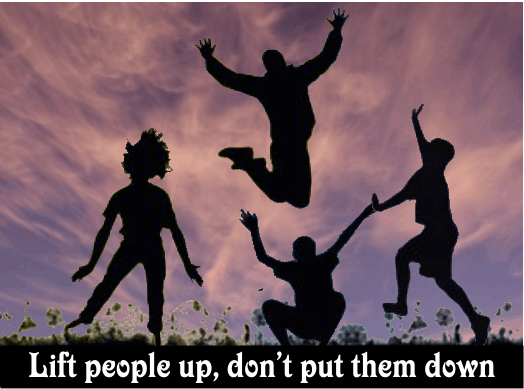










Popular Articles
Crazy-Makers: Dealing with Passive-Aggressive People
Why Are People Mean? Don't Take It Personally!
Struggling to Forgive: An Inability to Grieve
The Secret of Happiness: Let It Find You (But Make the Effort)
20 Steps to Better Self-Esteem
7 Rules and 8 Methods for Responding to Passive-aggressive People
What to Do When Your Jealousy Threatens to Destroy Your Marriage
Guide to How to Set Achieveable Goals
Catastrophe? Or Inconvenience?
Popular Audios
Audio Version of Article: Crazy-Makers: Passive-Aggressive People
Audio Version of Article: Why Are People Mean? Don't Take It Personally!
Index
Previous Next
50 RULES OF LIFE
Rule 8: Lift People Up, Don't Put Them Down
What is this concept of wishing others well?
Many philosophical lines of thought over the ages focus on the importance of how we treat others. “There is no exercise better for the heart than reaching down and lifting people up (John Andrew Holmes, 1773-1843).” When messages converge over the millennia there must be an element of truth in them:
1) Karma.
Hindu texts written three to four thousand years ago referred to the concept of karma which is defined as experiencing good or bad outcomes in one's life (or lives) depending upon past behavior. In other words, good things are more likely to happen to you if you live a good life and bad things are likely to happen if you don't.
 2) Loving-kindness.
2) Loving-kindness. About 2500 years ago Buddha sought the answer to the question of how to end suffering. His quest yielded the concepts of loving-kindness and compassion for others. Similar to karma, having an attitude of loving-kindness and treating others with kindness and compassion reduced suffering in the individual.
3) The Golden Rule.
Two thousand years ago, Jesus taught “do unto others as you would have them do unto you” which had its roots in the Torah (Old Testament) instruction “Love thy neighbor as thyself.” This concept which has become known as “the Golden Rule” is present in some form in most of the world's religions including Christianity, Judaism, and Islam.
4) Self-fulfilling prophecy.
Finally, psychology has shown through various lines of research that a person's perceptions tend to influence outcomes (Rosenthal, 2003). For example, if a person believes others will mistreat him, he is likely to be mistreated because his expectation affects how he treats others which influences their behavior towards him.
Why DO we want to wish others well?
Aside from it makes the world a nicer place, the main reason for wishing others well may seem like a selfish reason: the more that we can bestow loving-kindness and compassion on others, the more we experience peace and contentment ourselves. In addition, others tend to respond in kind and we reap even more positive outcomes.
Researchers Fredrickson and colleagues (2008) showed that nine weeks of loving-kindness meditation produced significant changes in the participants' lives. In particular, they experienced increased positive emotions which improved a number of areas in their lives including degree of self-acceptance, relationships, physical health, sense of purpose, and satisfaction with life. In addition, it decreased symptoms of depression. Interestingly, the researchers found that it wasn't the increased positive emotions that impacted the participants' lives but that the positive emotions set people on a path that increased their personal resources. For instance, when positive emotions increased, they were more likely to seek social contact, pursue meaningful activities, and take care of their physical health.
What about people who take advantage of our good nature?
Some people are concerned that loving-kindness towards others may make them more vulnerable to those willing to take advantage of kindhearted people. The message here, however, is that the attitude of loving kindness created through meditation influences your life in positive ways. Since this is an internal attitude, it can't be taken away from you. Also, loving-kindness doesn't mean that you need to allow yourself to be vulnerable. You can still protect yourself emotionally and physically while having an attitude of loving-kindness and compassion towards those who might harm you.
Fredrickson, B.L., Cohn, M.A., Coffey, K.A., Pek, J. and Finkel, S.M. (2008). Open Hearts Build Lives: Positive Emotions, Induced Through Loving-Kindness Meditation, Build Consequential Personal Resources. Journal of Personality and Social Psychology, 95, 1045–1062. DOI: 10.1037/a0013262
Rosenthal, R. (2003). Covert communication in laboratories, classrooms, and the truly real world. Psychological Science, 12, 151–155.
Rosenthal, R. (2003). Covert communication in laboratories, classrooms, and the truly real world. Psychological Science, 12, 151–155.
Copyright © 2014 Excel At Life, LLC.
Permission to post this article is granted if it includes this entire copyright and an active link.
Permission to post this article is granted if it includes this entire copyright and an active link.













